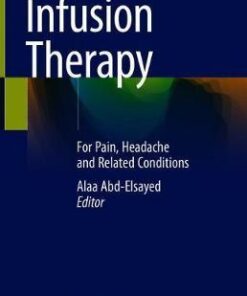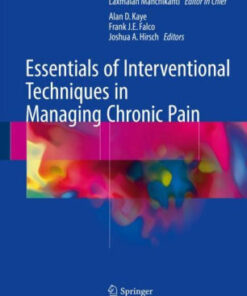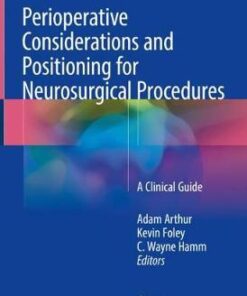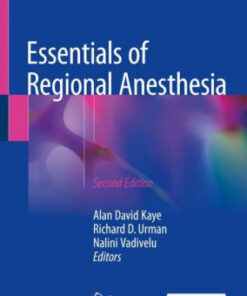(PDF) Analgesia, Anaesthesia and Pregnancy 4th Ed by Monteiro
$18.00
Download instantly Analgesia, Anaesthesia and Pregnancy – A Practical Guide 4th Edition by Róisín Monteiro, Marwa Salman, Surbhi Malhotra, Steve Yentis. It is ebook in PDF format.
ISBN-10: 1108710522 ISBN-13: 9781108710527
Preview
This is the PDF eBook version for Analgesia, Anaesthesia and Pregnancy – A Practical Guide 4th Edition by Róisín Monteiro, Marwa Salman, Surbhi Malhotra, Steve Yentis
Table of Contents
1. Assisted fertility; 2. Ovarian hyperstimulation syndrome; 3. Anaesthesia before confirmation of pregnancy; 4. Ectopic pregnancy; 5. Evacuation of retained products of conception; 6. Termination of pregnancy; 7. Cervical suture (cerclage); 8. Incidental surgery in the pregnant patient; 9. Intrauterine surgery; 10. Anatomy of the spine and peripheral nerves; 11. Physiology of pregnancy; 12. Antenatal care; 13. Aortocaval compression; 14. Gastric function and feeding in labour; 15. Drugs and pregnancy; 16. Placental transfer of drug; 17. Prescription and administration of drugs by midwives; 18. Local anaesthetics; 19. Normal labour; 20. Intrapartum fetal monitoring; 21. Pain of labour; 22. Non-pharmacological analgesia; 23. Inhalational analgesic drugs; 24. Systemic analgesic drugs; 25. Intravenous patient-controlled analgesia for labour; 26. Epidural analgesia for labour; 27. Epidural test doses; 28. Spinal analgesia; 29. Combined spinal–epidural analgesia and anaesthesia; 30. Spinal and epidural opioids; 31. Pre-operative Assessment; 32. Operative vaginal delivery (Instrumental delivery); 33. Caesarean section; 34. Spinal anaesthesia for caesarean section; 35. Epidural anaesthesia for caesarean section; 36. General anaesthesia for caesarean section; 37. Cricoid pressure; 38. Failed and difficult intubation; 39. Awake intubation; 40. Removal of retained placenta and perineal suturing; 41. Postoperative analgesia; 42. Enhanced recovery; 43. Bloody tap; 44. Dural puncture; 45. Postdural puncture headache; 46. Epidural blood patch; 47. Extensive regional block; 48. Inadequate regional analgesia in labour; 49. Breakthrough pain during caesarean section; 50. Backache; 51. Chronic pain post-caesarean section; 52. Horner’s syndrome and cranial nerve palsy; 53. Peripheral nerve lesions following regional anaesthesia; 54. Spinal cord lesions following regional anaesthesia; 55. Arachnoiditis; 56. Cauda equina syndrome; 57. Opioid-induced pruritus; 58. Shivering; 59. Aspiration of gastric contents; 60. Awareness; 61. Air embolism; 62. Malignant hyperthermia; 63. Induction and augmentation of labour; 64. Oxytocic and tocolytic drugs; 65. Premature labour, delivery and rupture of membranes; 66. Malpresentations and malpositions; 67. External cephalic version; 68. Multiple pregnancy; 69. Vaginal birth after caesarean section; 70. Under-age pregnancy and advanced maternal age; 71. Abnormal placentation; 72. Placental abruption; 73. Cord prolapse; 74. Fetal distress; 75. Shoulder dystocia; 76. Intrauterine death; 77. Uterine inversion; 78. Major obstetric haemorrhage; 79. Postpartum haemorrhage; 80. Collapse on labour ward; 81. Maternal cardiopulmonary resuscitation; 82. Amniotic fluid embolism; 83. Cholestasis of pregnancy (obstetric cholestasis); 84. Acute fatty liver of pregnancy; 85. HELLP syndrome; 86. Hypertension, pre-eclampsia and eclampsia; 87. Magnesium sulphate; 88. Hyperemesis gravidarum; 89. Maternal mortality; 90. Allergic reactions; 91. Cardiovascular disease; 92. Arrhythmias; 93. Pulmonary oedema; 94. Cardiomyopathy; 95. Coarctation of the aorta; 96. Aortic dissection; 97. Valvular heart disease; 98. Congenital heart disease; 99. Pulmonary hypertension and Eisenmenger’s syndrome; 100. Ischaemic heart disease; 101. Endocrine disease; 102. Diabetes mellitus; 103. Anaemia and polycythaemia; 104. Deep-vein thrombosis and pulmonary embolism; 105. Thrombophilia; 106. Coagulopathy; 107. Von Willebrand’s disease and haemophilia; 108. Disseminated intravascular coagulation; 109. Thrombocytopenia; 110. Lymphoma and leukaemia; 111. Haemoglobinopathies; 112. Connective tissue disorders; 113. Rheumatoid arthritis; 114. Cervical spine disorders; 115. Kyphoscoliosis; 116. Low back pain in pregnancy; 117. The parturient with chronic pain; 118. Neurological disease; 119. Meningitis; 120. Acute post-infective peripheral neuropathy (Gui




